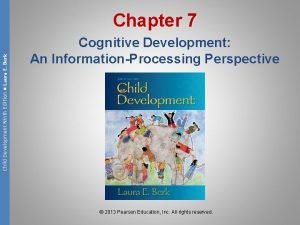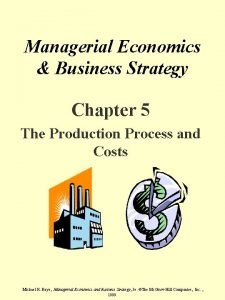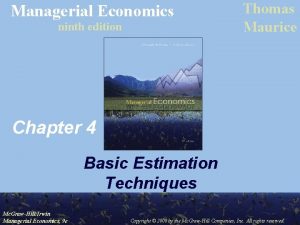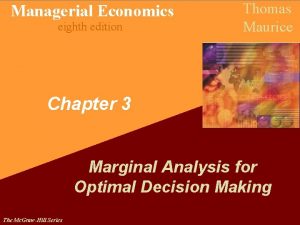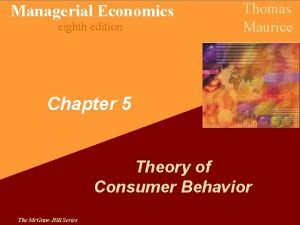Managerial Economics ninth edition Thomas Maurice Chapter 3















- Slides: 15

Managerial Economics ninth edition Thomas Maurice Chapter 3 Marginal Analysis for Optimal Decision Making Mc. Graw-Hill/Irwin Managerial Economics, 9 e Copyright © 2008 by the Mc. Graw-Hill Companies, Inc. All rights reserved.

Managerial Economics Optimization • An optimization problem involves the specification of three things: • Objective function to be maximized or minimized • Activities or choice variables that determine the value of the objective function • Any constraints that may restrict the values of the choice variables 3 -2

Managerial Economics Choice Variables • Choice variables determine the value of the objective function • Continuous variables • Can choose from uninterrupted span of variables • Discrete variables • Must choose from a span of variables that is interrupted by gaps 3 -3

Managerial Economics Net Benefit • Net Benefit (NB) • Difference between total benefit (TB) and total cost (TC) for the activity • NB = TB – TC • Optimal level of the activity (A*) is the level that maximizes net benefit 3 -4

Managerial Economics Optimal Level of Activity (Figure 3. 1) Total benefit and total cost (dollars) TC 4, 000 D • • D’ 3, 000 B 2, 310 • 2, 000 1, 085 1, 000 • F • • B’ • C’ 0 200 TB NB* = $1, 225 C • G A 350 = A* 600 700 1, 000 Level of activity Net benefit (dollars) Panel A – Total benefit and total cost curves 1, 225 1, 000 • c’’ • • 600 0 3 -5 M Panel B – Net benefit curve d’’ 200 350 = A* 600 A f’’ • Level of activity 1, 000 NB

Managerial Economics Marginal Benefit & Marginal Cost • Marginal benefit (MB) • Change in total benefit (TB) caused by an incremental change in the level of the activity • Marginal cost (MC) • Change in total cost (TC) caused by an incremental change in the level of the activity 3 -6

Managerial Economics Marginal Benefit & Marginal Cost 3 -7

Managerial Economics Relating Marginals to Totals • Marginal variables measure rates of change in corresponding total variables • Marginal benefit & marginal cost are also slopes of total benefit & total cost curves, respectively 3 -8

Managerial Economics Relating Marginals to Totals (Figure 3. 2) Total benefit and total cost (dollars) TC 4, 000 100 320 3, 000 100 • B 520 100 2, 000 640 • C C’ • • F • TB 820 100 • B’ 1, 000 • D D’ • G 520 100 340 A 100 0 200 350 = A* 600 800 1, 000 Level of activity Panel A – Measuring slopes along TB and TC Marginal benefit and marginal cost (dollars) MC (= slope of TC) 8 c (200, $6. 40) 6 5. 20 4 2 b • • c’ (200, $3. 40) d (600, $3. 20) • MB (= slope of TB) g 0 3 -9 • • d’ (600, $8. 20) 200 350 = A* Panel B – Marginals give slopes of totals 600 Level of activity 800 • 1, 000 A

Managerial Economics Using Marginal Analysis to Find Optimal Activity Levels • If marginal benefit > marginal cost • Activity should be increased to reach highest net benefit • If marginal cost > marginal benefit • Activity should be decreased to reach highest net benefit • Optimal level of activity • When no further increases in net benefit are possible • Occurs when MB = MC 3 -10

Managerial Economics Using Marginal Analysis to Find A* (Figure 3. 3) Net benefit (dollars) MB = MC MB > MC 100 300 0 • c’’ 200 MB < MC M • 100 • d’’ 350 = A* 600 500 A 800 NB Level of activity 3 -11 1, 000

Managerial Economics Unconstrained Maximization with Discrete Choice Variables • Increase activity if MB > MC • Decrease activity if MB < MC • Optimal level of activity • Last level for which MB exceeds MC 3 -12

Managerial Economics Irrelevance of Sunk, Fixed, & Average Costs • Sunk costs • Previously paid & cannot be recovered • Fixed costs • Constant & must be paid no matter the level of activity • Average (or unit) costs • Computed by dividing total cost by the number of units of the activity • These costs do not affect marginal cost & are irrelevant for optimal decisions 3 -13

Managerial Economics Constrained Optimization • The ratio MB/P represents the additional benefit per additional dollar spent on the activity • Ratios of marginal benefits to prices of various activities are used to allocate a fixed number of dollars among activities 3 -14

Managerial Economics Constrained Optimization • To maximize or minimize an objective function subject to a constraint • Ratios of the marginal benefit to price must be equal for all activities • Constraint must be met 3 -15
 Managerial economics 12th edition mark hirschey
Managerial economics 12th edition mark hirschey Levels of analysis psychology
Levels of analysis psychology Macroeconomics
Macroeconomics Human anatomy & physiology edition 9
Human anatomy & physiology edition 9 Psychology ninth edition david g myers
Psychology ninth edition david g myers Social psychology ninth edition
Social psychology ninth edition Biology ninth edition
Biology ninth edition Laura e berk child development (9th edition pdf)
Laura e berk child development (9th edition pdf) Berk 2013 child development
Berk 2013 child development Abnormal psychology comer 9th edition
Abnormal psychology comer 9th edition Psychology ninth edition in modules
Psychology ninth edition in modules Psychology ninth edition david g myers
Psychology ninth edition david g myers Biology ninth edition
Biology ninth edition Campbell ninth edition
Campbell ninth edition Managerial economics chapter 5
Managerial economics chapter 5 Fundamental concepts of business economics
Fundamental concepts of business economics







